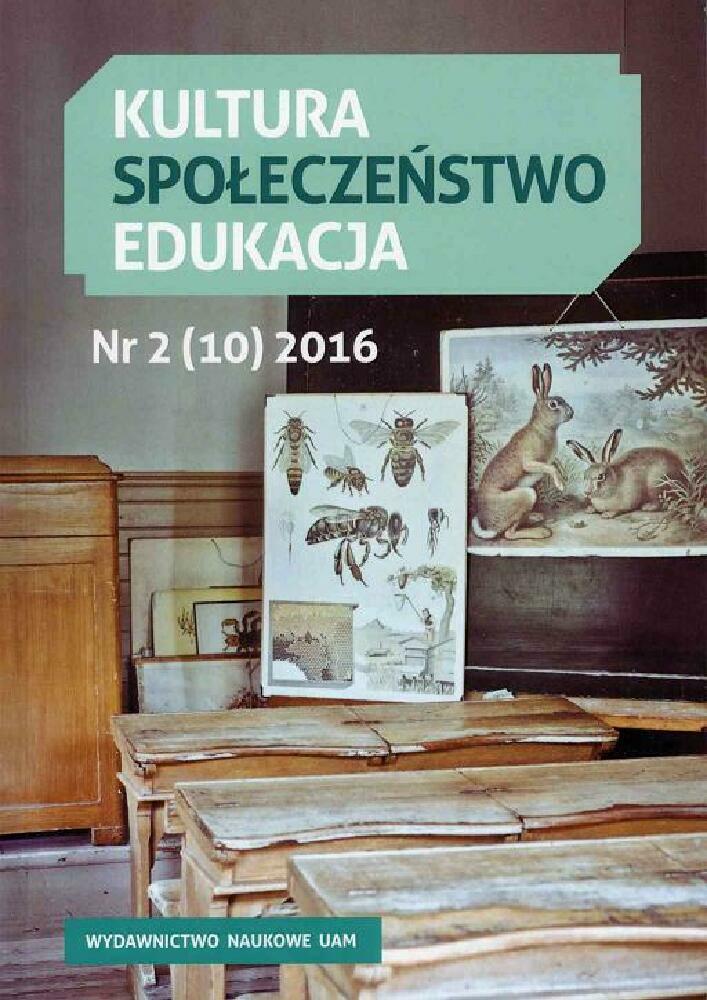Abstrakt
In the paper, apart from interpreting the message of films: Carrie (directed by Brian De Palma), Over the Edge (directed by Jonathan Kaplan) and Elephant (directed by Gus Van Sant), I also describe how classes can be arranged around them. Thus, I join the debate on the space for such productions in education, especially in the methodology for training teachers-to-be. I indicate possible applications of feature films and a wide spectrum of benefits that follow from this approach. In fact, movies are still an undervalued but very effective didactic tool that engages pupils in authentic intellectual tasks that deal with important content and issues.
Bibliografia
Anderson J. (2013). Active Learning through Student Film: A Case Study of Cultural Geography. “Journal of Geography in Higher Education” Vol. 37, No. 3.
Chant R.H., Heafner T.L., Bennett K.R. (2004). Connecting personal theorizing and action research in preservice teacher development. “Teacher Education Quarterly” 31(3).
Creating Effective Teaching and Learning Environments: First Results from TALIS, http://www.oecd.org/edu/school/creatingeffectiveteachingandlearningenvironmentsfirstresultsfromtalis.htm [dostęp: 18.08.2015].
Cunneen J. (2003). “Elephant” is elegiac. “National Catholic Reporter” 21 November.
Dudzikowa M. (2007). Pomyśl siebie… Minieseje dla wychowawcy klasy. Gdańsk.
Dymond E.J. (2013). An examination of the use of gendered languagein Stephen King’s CARRIE. “The Explicator” Vol. 71, No. 2.
Ehlers L.A. (1981). „Carrie”. Book and film, “Literature/Film Quarterly” No 1.
http://film.onet.pl/ wiadomosci/glosy-prasy/x5rj4, dostęp: 18.08.2015.
http://stopklatka.pl/wiadomosci/-/6964299,nagrodzony-zlota-palma-w-cannes-slon-juz-w-kinach, dostęp: 18.08.2015.
http://www.imdb.com/title/tt0079688/trivia, dostęp: 18.08.2015.
Jagodzińska M. (2008). Psychologia pamięci. Badania, teorie, zastosowania. Gliwice.
Jenkins D. (2012). The Nightmare and the narrative. “Dreaming” Vol. 22, No. 2.
Jones K. (2003). Corridors of powerlessness: Elephant. “FilmComment” No. 9–10.
Kaçkaya A., Ünlü I., Akar M. S., Özturan Sagirli M. (2011). The effect of school and teacher themed movies on pre-service teachers’ professional attitudes and perceived self-efficacy. “Educational Sciences: Theory & Practice” 11(4).
King S. (1974). Carrie. New York.
Klichowski M., Bonanno P., Jaskulska S., Smaniotto Costa C., de Lange M., Klauser F.R. (2015).
CyberParks as a new context for smart education: theoretical background, assumptions and preservice teachers’ rating. “American Journal of Educational Research” No. 3(12).
Koon B., Finefrock J.A. (1973). Mousepacks: Kids on a Crime Spree. “San Francisco Examiner” 11 Nov.
Melosik Z. (2013). Kultura popularna i tożsamość młodzieży. W niewoli władzy i wolności. Kraków.
Porton R. (2003). Festival de Cannes 2003. “Cineaste” Fall.
Rich J.A. (2012). Shock corridors: the new rhetoric of horror in Gus Van Sant’s Elephant, “The Journal of Popular Culture” Vol. 45, No. 6.
Richardson V. (1997). Constructivist teaching and teaching education: Theory and practice. [In:] V. Richardson (ed.). Constructivist Teacher Education: Building a World of New Understandings. Bristol.
Rorrer A.S., Furr S. (2009). Using film as a multicultural awareness tool in teacher education. “Multicultural Perspectives” 11(3).
Russell III W.B. (2012). The art of teaching social studies with film. “The Clearing House” 85.
Sacks M. (2009). Over the Edge. “Vice”, 1 September, http://www.vice.com/read/over-the-edge-134-v16n9, dostęp: 18.08.2015.
Stephens Ch. (2005). Recommended: Over the Edge. “FilmComment”.
Stoddard J.D., Marcus A.S. (2010). More than „showing what happened”: exploring the potential of teaching history with film. “The High School Journal” Jan/Feb..
Wonderly M. (2009). Children’s film as an instrument of moral education. “Journal of Moral Education” Vol. 38, No 1.
Zamojska E. (2011). Szkoła w filmie. Czy tylko fikcja? Analiza obrazu rzeczywistości szkolnej w filmie „Klasa” („Entre les murs”). [W:] W. Jakubowski, S. Jaskulska (red.). Kultura mediów, ciało i tożsamość – konteksty socjalizacyjne i edukacyjne. Kraków.
Filmografia
De Palma B. (reż.), Carrie, USA 1976.
Kaplan J. (reż.), Nad krawędzią, USA 1979.
Morgen B. (reż.), Kurt Cobain: Montage of Heck, USA 2015.
Van Sant G. (reż.), Słoń, USA 2003.
Licencja
Prawa autorskie (c) 2017 Sylwia Jaskulska

Utwór dostępny jest na licencji Creative Commons Uznanie autorstwa – Bez utworów zależnych 4.0 Międzynarodowe.
